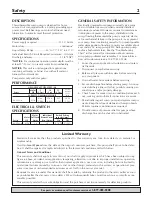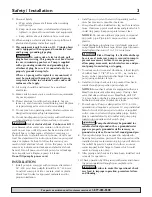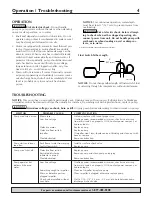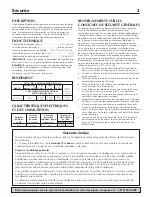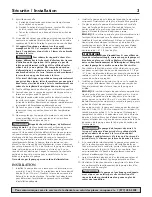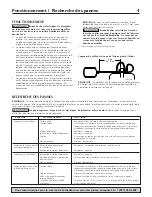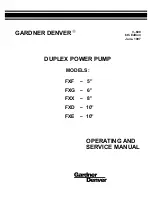
Safety / Installation
3
For parts or assistance, call customer service at
1-877-455-5508
9. Personal Safety:
a. Wear safety glasses at all times when working
with pumps.
b. Keep work area clean, uncluttered and properly
lighted – replace all unused tools and equipment.
c. Keep visitors at a safe distance from work area.
10. When wiring an electrically driven pump follow all
electrical and safety codes that apply.
11.
This equipment is only for use on 115 V (single phase)
and is equipped with an approved 3-conductor cord
and 3-prong, grounding-type plug.
To reduce risk of electric shock, pull
plug before servicing. This pump has not been tested
for use in swimming pool areas. Pump is supplied
with a grounding conductor and grounding-type
attachment plug. Be sure it is connected only to a
properly grounded receptacle.
Where a 2-prong wall receptacle is encountered, it
must be replaced with properly grounded 3-prong
receptacle installed in accordance with codes and
ordinances that apply.
12. All wiring should be performed by a qualified
electrician.
13. Make certain power source conforms to requirements
of your equipment.
14. Protect electrical cord from sharp objects, hot sur-
faces, oil, and chemicals. Avoid kinking cord. Replace
or repair damaged or worn cords immediately.
15. Do not touch an operating motor. Modern motors are
designed to operate at high temperatures.
16. Do not handle pump or pump motor with wet hands or
when standing on wet or damp surface, or in water.
Risk of electrical shock. Can burn or kill.
If
your basement has water or moisture on floor, do not
walk on wet area until all power has been turned off. If
shut-off box is in basement, call electric company or
hydro authority to shutoff service to house, or call your
local fire department for instructions. Remove pump and
repair or replace. Failure to follow this warning can
result in fatal electrical shock. Oil on the pump or in the
sump may indicate motor leakage and electrical shock
hazard. Turn off power and check pump for oil leakage
from impeller area. Replace pump if it leaks.
Do not lift pump by power cord.
INSTALLATION
1. Install pump in sump pit with minimum diameter of
14" (356 mm). Sump depth should be 14" (356 mm).
Construct sump pit of tile, concrete, steel or plastic.
Check local codes for approved materials and for
proper installation.
2. Install pump in pit so that switch operating mecha-
nism has maximum possible clearance.
3. Pump should not be installed on clay, earth or sand sur-
faces. Clean sump pit of small stones and gravel which
could clog pump. Keep pump inlet screen clear.
NOTICE:
Do not use ordinary pipe joint compound
on plastic pipe. Pipe joint compound can corrode
plastics.
4. Install discharge plumbing. Use rigid plastic pipe and
wrap threads with Teflon
TM
tape. Screw pipe into pump.
Hand tighten then turn it 1 to 1 1/2 more turns.
Risk of flooding. If a flexible discharge
hose is used, make sure pump is secured in sump to
prevent movement. Failure to secure pump may
allow pump movement, switch interference and pre-
vent pump from starting or stopping.
5. To reduce motor noise and vibrations, a short length
of rubber hose (1 7/8" (47.6 mm) I.D., e.g. radiator
hose) can be connected into discharge line near
pump using suitable clamps.
6. Install an in-line check valve to prevent flow back-
wards through pump when pump shuts off.
NOTICE:
Some check valves are equipped with an air
bleed hole to prevent airlocking pump. If using check
valve that does not have an air bleed hole, drill 1/8"
(3.2 mm) hole in discharge pipe just above pump body
but below check valve to prevent air locks.
7. Power Supply: Pump is designed for 115 V, 60 Hz.,
operation and requires a minimum 10 amp individual
branch circuit. Both pump and switch are supplied
with 3-wire cord sets with grounding plugs. Switch
plug is inserted directly into outlet and pump plug
inserts into opposite end of switch plug.
Pump should always be grounded to a
suitable electrical ground such as a grounded water
pipe or a properly grounded metallic raceway, or
ground wire system. Do not cut off round ground pin.
8. If pump discharge line is exposed to outside sub-
freezing temperature, portion of line exposed must be
installed so any water remaining in pipe will drain to
the outfall by gravity. Failure to do this can cause
water trapped in discharge to freeze which could
result in damage to pump.
9. After piping and check valve have been installed, unit
is ready for operation.
10. Check operation by filling sump with water and observ-
ing pump operation through one complete cycle.
Failure to make this operational check
may lead to improper operation, premature failure,
and flooding.


